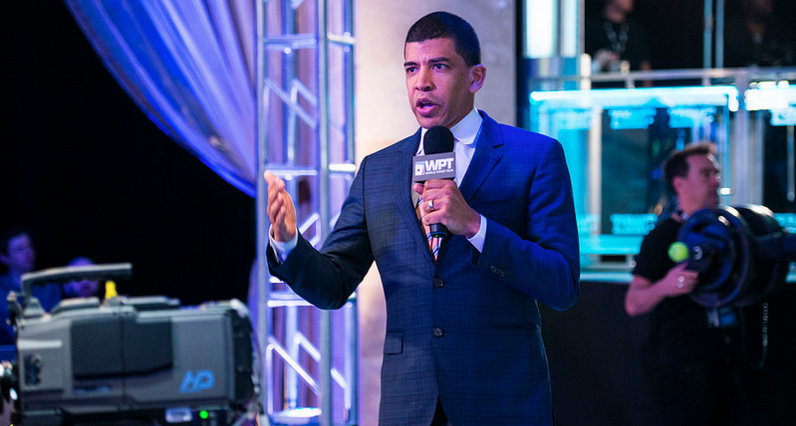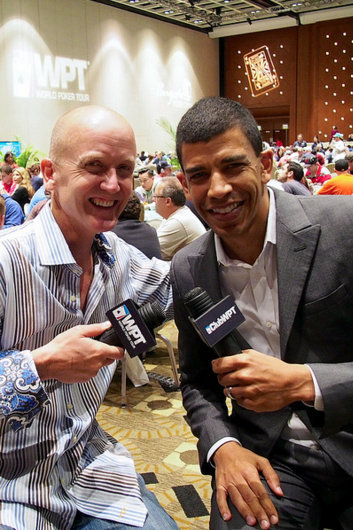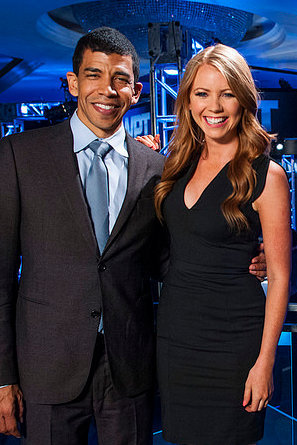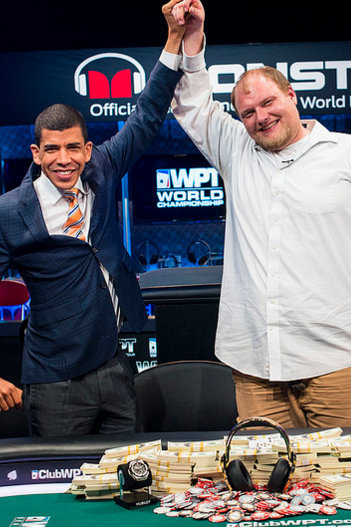






Poker Industry Focus: Q&A With World Poker Tour President And CEO Adam PliskaWorld Poker Tour Head Discusses Tournament Poker's Shifting Landscape, International Expansion and More |
|
|

Adam Pliska was introduced as the President and CEO of the World Poker Tour in 2009, and immediately oversaw a major revamp of the brand that had helped shape the poker boom of the early 2000’s. Due to industry wide changes, Pliska has been at the helm while the WPT evolved from a single tour focused around $10,000 to $25,000 buy-in tournaments to a multi-pronged group of tours targeting buy-ins from $500 up to $100,000. The tournament side of the business is also just one small facet of the company, which also produces the WPT television broadcasts, runs subscription poker site ClubWPT.com and also licenses it’s name and brand to other companies, like pinball machine and poker chip manufacturers.
Card Player caught up with Pliska just before the New Year to discuss how the WPT has responded to the evolving industry landscape, the relationship between poker and TV and more.
Erik Fast: During your tenure it seems that the business of poker has changed a lot. Televised poker and the stars that played were in many ways subsidized by the major international online poker sites. Legal shifts have made it necessary for businesses and players alike to adapt. Can you talk about how things have changed?
Adam Pliska: Before accepting my current role I was a general counsel for the WPT. There was a time before the subsidizing of the online sites. In 2003 we were truly a production company with 87 percent of our revenues coming license fees from our TV shows. The online sites saw the success of the show and came in and subsidized the shows, but then after a while we were forced to change in the wake of 2006 and the UIGEA. You have to adjust, but there is good news in all of this. The poker market has diversified, and while that might not give you the same windfalls that came in the gold rush boom times, it gives you a more stable base as a company.
 EF: The shift in the poker world following the UIGEA and Black Friday made it necessary for companies such as the WPT to change their approach. Now instead of having between 10 and 20 events with buy-ins of $10,000 to $25,000 dollars you guys have a lot more diversity, in buy-in price point and location. Can you about those changes?
EF: The shift in the poker world following the UIGEA and Black Friday made it necessary for companies such as the WPT to change their approach. Now instead of having between 10 and 20 events with buy-ins of $10,000 to $25,000 dollars you guys have a lot more diversity, in buy-in price point and location. Can you about those changes?
AP: I would like to say that 14 years ago we were only thinking about making sure that a person had a perfect journey from the lower buy-ins to the highest, but that would not be true. We had large prestigious events like [the Five Diamond World Poker Classic] at the Bellagio, and $10,000 buy-ins up to $25,000 were pretty much all we offered. As the demand for lower buy-ins increased, as a result of the changes in the economy and increased interest from players who wanted to try poker but not at the entry point of five figures. We started to do WPT National and WPT Regional events, that all featured buy-ins of $3,500 or less. We then also noticed on the other side of the spectrum there also a demand for higher stakes tournaments, with the WPT Alpha8 tournaments sporting buy-ins of $100,000 or more targeted at the high-stakes professionals and business people who are fans of the game. In recent years we joined forces to create WPT DeepStacks, for people who love a lower price point that is treated with the same attention and care as the bigger events. So things have evolved to the point that anybody interested in the game can play within our WPT system. If you want to play for free you can go on ClubWPT.com, you can play at the mid-major price points in WPTDeepStacks or WPT National events, you can play the main tour events or even the Alpha8. We have something to offer everyone, no matter where they are in the poker world.
EF: Not only have you diversified the buy-ins available for World Poker Tour events in recent years, you’ve also overseen a lot of expansion in regards to where tournaments are held around the country and across the globe. Can you talk a little bit about bringing the WPT to places like China, South Africa and expanding the number of events and Europe?
AP: One of the comments that I’m often asked to respond to is: “We are in the post-boom times for poker.” My response is that the poker boom has not stopped, it’s just continued to move. Newer areas are more educated, having several years of mainstream poker coverage to look back at. We had 888 players in our event this year on the Chinese island of Sanya. Just to see that event progress over its first three years has been interesting. The first year there, players were celebrating, standing up, throwing chips in excitement. Already by this year it was very professional and just such a great event. So we see that developing and that poker is expanding in certain markets. And from our perspective these new opportunities are great, because we are a very agile company. You can come in with a good idea and there are only one or two levels of yes and no. That has helped us a lot expanding from 14 events up to nearly 70. Quite frankly, after that, I came to the conclusion that perhaps we had expanded too far. I don’t expect us to move up to 80 or 90 events. I think that we are in a nice place now.
 EF: The business is multi-faceted, as you said. There is the aspect of the WPT that is running these events, but of course there is also the media side. The WPT first came to prominence because of TV. Has the way technology is changing media in recent years had a large effect on how you approach that side of your business?
EF: The business is multi-faceted, as you said. There is the aspect of the WPT that is running these events, but of course there is also the media side. The WPT first came to prominence because of TV. Has the way technology is changing media in recent years had a large effect on how you approach that side of your business?
AP: If you look at the evolution of the TV show, at the beginning our WPT episodes would have the re-airs rate as high or higher than the initial broadcast, which is something I never saw in all my years before that working in TV. I think that had to do with people watching the final tables over and over again because we were in an education period. Now, what I think is happening in TV, is that it still plays an important role. It’s just a different role. In a way it’s like a survey course, telling people that there is material out there. You can find the World Poker Tour playing nearly every day and even if people catch five minutes of an episode, they are reminded that poker is alive and well. And I believe that is good for us, that is good for the WSOP and Heartland Poker Tour and all of the other tours. We are getting the message out and reminding people the game is out there and it is dynamic and growing.
As far as the more interactive types of media, we are going to do more and more live streaming and interactive media. We are not going to abandon our high-end production values, but we are going to have a lot more online media and a lot more things that are accessible in smaller doses.
EF: Poker on TV isn’t quite like traditional sporting events, which people don’t re-watch as much because the entertainment value is limited once the outcome is known. In poker, however, people seem to find the process interesting even if they know the result.
AP: TV is never cheap. If someone is a completely dedicated fan of the game they would watch the top players even if there was just one camera broadcasting them with no production value. But if you are just a casual viewer, that kind of thing would not draw you in. The World Poker Tour has producers who have been there for a decade and they are still here to tell stories. It’s treated like a five-act play in a way. We compose all of the music ourselves and it’s almost broken up like a movie. It is a very, very expensive thing to produce, but over the long run we think it’s worth it.
EF: In the past few years poker players have had their voices magnified by social media. Being a public face for this company, do you deal with a lot of comments, suggestions and complaints from people?
AP: It really has improved us. It’s the poker community, so there are a lot of very passionate people. When we do something that people don’t like, you do get a lot of comments but that’s perfectly fine. Even if only 10 or 15 percent of it is constructive, that’s still a great help. It was only five years or so ago that we started to make changes, like adding Tony Dunst to do critical analysis of hands. For a long time it was thought that you couldn’t do that. We were very Pollyanna-ish. Everybody was a ‘good guy’ and we didn’t comment on how people played. But players were telling us, ‘come on. We don’t need to be coddled anymore.’ And that inspired the decision to add Tony. Adding the coverage of play down to the final table was also a result of player feedback. They were saying, ‘God didn’t create six people and just sit them down at the final table. This was a long journey.’ I think some of the best input we’ve had is from the community. We’re running a business at the end of the day and can’t always incorporate all of it, but I think you take the criticism in exchange for the changes it inspires.
 EF: The touchstones of the show remain, Vince Van Patten and Mike Sexton calling the action for one, but there have been many tweaks and changes during your tenure. Can you talk a bit about the changes that have happened that you are proud of and what is in the works for the future?
EF: The touchstones of the show remain, Vince Van Patten and Mike Sexton calling the action for one, but there have been many tweaks and changes during your tenure. Can you talk a bit about the changes that have happened that you are proud of and what is in the works for the future?
AP: In terms of the TV show would say I’m proud of the fact that we’ve been able to make a shift into what I called “YES programming” at the time, meaning younger, edgier, sexier. We wanted to treat poker as a sport. In sports, people are passionate, they swear, they get frustrated. You saw more of the things that actually happen when you play. The show now is a far more genuine portrayal of what it feels like to go through the experience of a final table. I like that a lot. I also like that we still take the production values of the show very seriously and spend the money needed to maintain that. I think you can tell the difference.
In terms of the tour itself as opposed to the show, I think taking the risks involved in expanding into new countries was a big deal. When we made deals to expand into Asia, we weren’t really making any money off of that in the beginning. You’re just out there saying, “We are the World Poker Tour and hoping people show up.” It has taken off, but not without trial and error and some mistakes. So, I am very proud of the expansion in the last years because now we really are the world poker tour.
In the future we will be announcing some fun things related to our upcoming season XV. But what I will say now, in general, is that we are embracing media more than ever. We made our name from a high quality TV show. But media is changing and we are going to make sure that we deliver what people want in the ways that they want and make it easier to get. The World Poker Tour is going to focus on making sure that things are personal to people, special and as seamless as possible, whether it’s playing online, coming into a tournament, going to a party in Sanya or an Alpha8 event. We are going to push ourselves this year in ways that we haven’t.
EF: So earlier you said that you don’t accept the premise that the poker boom is behind us. That being said, the landscape has changed quite a bit, in relation to the online sites and their influence on TV, the aforementioned shifting media landscape, the general economy and beyond. There is a lot up in the air, and in your position, I’m sure you have to have your finger on the pulse of that. What are your general thoughts on the state of the industry and how it affects your business going forward?
AP: When I started working in TV there were basically four major networks. Then cable networks started coming out every other week. People decreed it as the end of TV. But recently some of the best programming in any entertainment format has come on TV and it’s lead to resurgence. So, to me that means that you have to embrace change. We need to realize that it’s not that the poker market went away. It’s expanded and it’s diversified. The social gaming industry is a multi-billion dollar market. We just need to be more open-minded and realize that people come into their journey at different entry points. They’ll come in wanting to play social, they’ll come in wanting to start at low buy-ins or even come in as serious players that are moving up to the main tour. For the World Poker Tour to succeed we need to service this interest in the game in a very flexible way and we need to ask ourselves, ‘What is next and how do we make it better, easy and special?’
As long as we keep pushing ourselves and aren’t stuck in our old model we will be fine. It is our biggest strength that we have such a wonderful legacy to be proud of. What it means to be a WPT champion will always remain as something that people aspire to. But we aren’t going to sit here and talk about the good old days all day long. The good days are ahead of us, we just need to be a company that is ready to adapt. Already in the past several years we have had to make major adjustments, and it made us better. Financially we are certainly a better company now, but more important than that I think it made us smarter.
EF: You’ve hinted that there is some news for the tour’s next season coming soon that you can’t quite share yet. You’ve already made some big announcements recently, including dramatic changes to the season-ending event. What once was the WPT Championship is now a Tournament of Champions. Can you talk about that?
 AP: The championship was here at Bellagio for years and we moved it out to the Borgata. In the beginning people’s reaction to that was like, ‘You’re messing with something that is such a tradition.’ But we need to continue to embrace change, and since that move the events here at Bellagio has gotten better. The Five Diamond main event has grown the past two years.
AP: The championship was here at Bellagio for years and we moved it out to the Borgata. In the beginning people’s reaction to that was like, ‘You’re messing with something that is such a tradition.’ But we need to continue to embrace change, and since that move the events here at Bellagio has gotten better. The Five Diamond main event has grown the past two years.
EF: Back in the day there were four main events here each year, and if players came out for all of those main events they would spend nearly a month in the same casino! It was perhaps too much.
AP: It’s okay for us to say things can be too much. So we moved to New Jersey, and it was a great way to introduce online gaming there. This year we have moved to the Seminole Hard Rock Hotel & Casino in Hollywood, Florida and as you said the event is going to be a Tournament of Champions. For the first time the WPT Championship will crown a definitive champion from among previous WPT winners. This significant change has drawn some criticism, with people saying ‘I can’t come in and play.’ Some people are wondering if it will be well attended, some people are frustrated.
We are going to do our very best and make sure that people have a really, really great time. I think this is a good change for the WPT because it focuses on what the tour is all about. In our tour events anybody can come in and has a chance to join the elite group of World Poker Tour champions, joining an illustrious group. What this will do will reinforce how special it is to be a part of the champions club.
EF: It is an interesting concept. In a way it’s like a victory lap for the champions throughout the season and prior winners and a chance to once again represent themselves well on the big stage. When this change was announced, there was some reaction from players, champs from previous season who would have to buy in, who wondered if this is going to be a very attractive field to compete against. Do you have any response to these concerns?
AP: First of all, with humility I will ask you to please come out and support the event. If you are one of the select few who is eligible to play, do this. This is a chance for us to do something unique in poker and we need help. We all need to work together.
We are going to make sure they have another event to play in, and season XIV winners will be flown there and provided with accommodations that are all paid for. You are going to be playing in an event that can really solidify your position as a champion in the game. We are going to give this champion’s club franchise the attention and importance that it deserves. We are going to add more things,* the value is going to go up, but putting that aside I think that’s not the only way to look at this Tournament of Champions. You are there because it’s important that you are a champion and we want to give you the respect for that and this is the avenue for that.
*Earlier this week the World Poker Tour did indeed announce several additions to the schedule for the WPT Tournament of Champions season-ending festival, including a $2 million guaranteed $10,000 buy-in main tour event and a $25,000 buy-in high roller.
To learn more about the changes to the festival check out this article.
Photos courtesy of World Poker Tour.
